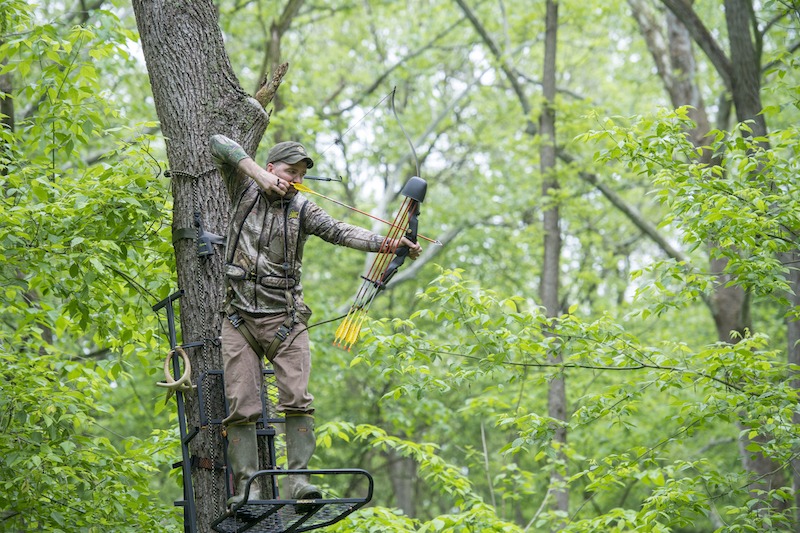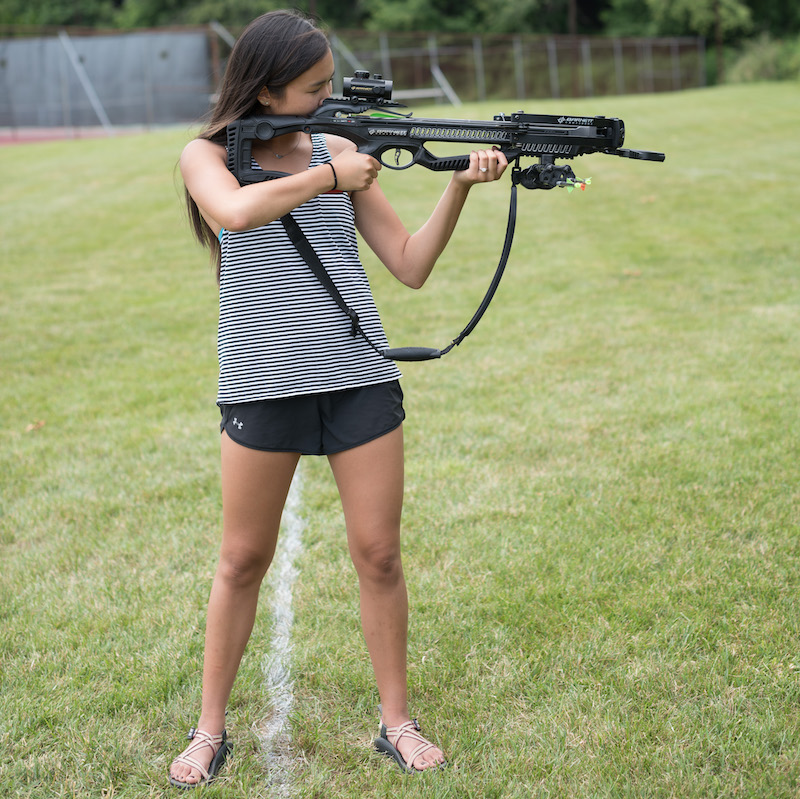Are you struggling to decide between a traditional bow, a compound bow or a crossbow? It’s a question every new bowhunter must consider, and so for help, we spoke to Michel Brooks, archery area manager at Jay’s Sporting Goods in Gaylord, Michigan. Brooks said each type of bow provides a unique recreational experience, and picking the best bow for you depends on your goals, time, skills and budget.
Generally speaking, traditional bows (including recurves and longbows) and compound bows are called vertical bows because their riser and limbs are perpendicular to the ground. A crossbow’s riser and limbs are parallel to the ground, making it a horizontal bow, although that isn’t a popular term. Here’s a look at each type, and the experience you’re likely to get from shooting them.

Traditional bows don’t require accessories, so they are slightly easier to manage. Photo Credit: ATA
Recurve and longbows are simple compared to other types. They don’t necessarily require a sight, stabilizer or arrow rest. Therefore, except for the bowstring, they don’t need much maintenance, which makes them rugged and reliable. However, traditional bows require lots of practice before a hunter can shoot consistently. And unlike with compound bows, the traditional bow’s entire draw weight must be pulled and held throughout the shot process. Furthermore, traditional bows generally aren’t as powerful as compound bows of the same draw weight. Once you become proficient, though, traditional bows are great for small-game hunting because you can quickly reload and shoot multiple arrows instinctively.
Recurves and longbows are the most challenging style of bow to learn, but it’s a challenge many bowhunters enjoy. And because they don’t require lots of accessories, a traditional bow can be less expensive to shoot than a compound or crossbow.
Compound bows are used to hunt a variety of game animals, and their speed, popularity and ease of use appeal to most new bowhunters. Unlike traditional bows, compounds use a series of cables and pulleys (called “cams”) to provide more force than the flex of the limbs alone. At the same time, those cables and cams create “let-off,” which greatly reduces the strength required to hold the bow at full draw, making it easier to take careful aim.
There are lots of compound bow options, too, which makes it easy to find a bow that feels comfortable to shoot. Many manufacturers offer different levels of bows, including beginner, midrange and flagship, all of which have different price points. Customers can find a “grow with me” bow that offers a draw weight adjustment in a 50-pound range. That allows the archer to increase their poundage as they get stronger. Other bows offer only 10 pounds of adjustment.
Unless you buy a whole package, you’ll have to purchase accessories such as a sight, an arrow rest, a stabilizer, a wrist strap and maybe a release aid for a compound bow. But if you buy high-quality accessories and a midrange bow to start, and you enjoy shooting a compound, you can always upgrade your bow and transfer the accessories over.

Crossbows are a great choice for bowhunters that don’t have a lot of time to practice. Photo Credit: ATA
Most crossbows offer good out-of-the-box accuracy, and they’re incredibly powerful, making them ideal for big-game hunting. Crossbow manufacturers sell mechanical cocking devices, too, which make it easy for hunters of all ages and abilities to cock and shoot these bows. This all makes crossbows family-friendly because everyone can use the same bow. They’re also great for people with limited upper body strength, shoulder injuries or little time to practice. Crossbow users become proficient quickly, which means they can spend more time focusing on the hunt.
Like compound bows, crossbows come in all price ranges, from beginner to high-end. Most new crossbows include the accessories you’re likely to need, such as a scope and arrows.
Crossbow regulations are more variable than vertical bow regulations. Some state wildlife agencies let all bowhunters use them, while other states allow them only for older or disabled hunters. Some states allow crossbows during specific parts of the season or on certain properties, while others make no distinction between crossbows and vertical bows as legal equipment. Check the regulations in your state to ensure you can legally hunt with a crossbow.
Brooks recommends hunters ask themselves the following questions before buying:
If you’re getting a traditional or compound vertical bow, you need to shop for one suited to the game animals you plan to hunt, and also your own physical capabilities. Big game, like deer and elk, requires more power to ensure a humane harvest. If you choose a vertical bow, it must have a heavy enough draw weight to do the job.
Each bow type requires a different level of skill and commitment to become proficient. Learning to shoot a traditional bow instinctively requires more time to perfect than shooting a compound bow does. And conditioning the muscles required to shoot a compound bow well requires more time than shooting a crossbow does.
State wildlife agencies regulate archery seasons and equipment criteria. Some states have minimum draw weight requirements for vertical bows, and crossbow regulations vary widely. Make sure you buy a bow that’s legal to hunt with in your area.
Picking a bow is similar to choosing a bike or vehicle. It’s best to take a test-drive before you buy. Visit a pro shop to work with a professional who will ensure you find what you need. First, they’ll ask questions to get to know your plans and budget. Then they’ll let you test different bows and models until you find one you like.
There should be no pressure to buy. Most retailers want to answer customer questions and provide an enjoyable shopping experience. Because of that, beginners should shop in person at a reputable pro shop rather than buy products online. In addition to providing tailored advice and assistance, pro shop experts will help you get set up and offer tips on shooting form. You might be tempted to buy products online for less, but you’ll end up wasting money if you buy the wrong thing. Pro shop staff will work with you to select a bow that fits properly and feels great. Use Bowhunting 360’s store locator to find an archery shop near you.
Each bow type has its pros and cons, so hunters must figure out what they value most before choosing what to buy. Whatever you decide, remember that you can change bows or bow types in the future. Many archers outgrow their setups (physically or mentally) or simply lust after a new bow’s high-tech features. Or you might find that you like using different bows for different types of hunts. If you get used to being successful with a crossbow every hunting season, the challenge of switching to a recurve can seem pretty appealing.